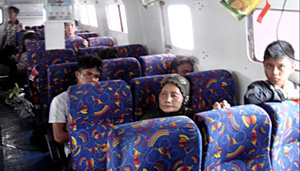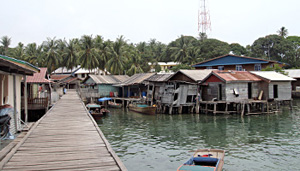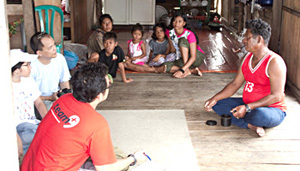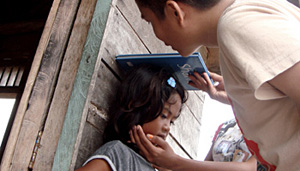By Willy T.
Edited by Law Diche
The Preparation: It all begins here
The Suku Laut (Suku = Tribe, Laut = Sea, hence Sea Tribe) is quite well known among people who live in Riau islands. This name also appeared in some local text book classifying them under the indigenous people of Riau, together with the Sakai Tribe, Akit Tribe, Utan Tribe, among others.
In Singapore where I live, you don’t really hear about these tribes in local publications. Ironically, we are probably more familiar with the Dayak, the African tribes and the Amazonian tribes, much more than our neighbouring one. That’s why after chatting with some friends, particularly Ranan who works in Bintan, we realised that we have almost forgotten that we have a neighbour who is still classified under indigenous community.
I’ve heard about this tribe more than 25 years ago and what I heard about their condition now is not so different. This drew a lot of curiosity so we decided to visit them to get firsthand knowledge. Thanks to some info from a friend who visited them before and modern technology, particularly Google, we managed to locate the community. Without these sources of information, we simply couldn’t imagine finding this group of 40 people among more than 2,400 islands of Riau Archipelago.
With the knowledge we gathered, we then equipped ourselves with several maps, satellite phone and life vests in case we need to travel using traditional boats in the opened sea.
First Stop: Tanjung Pinang
Volunteers from Singapore, Ade and me, were met with by a rather choppy sea and some rain when we caught the last ferry from Tanah Merah Ferry Terminal. We left Singapore around 6.30PM and reached Tanjung Pinang 7.30PM local time.
After clearing immigration, we headed to a nearby local hotel, a 10-minute walk from the harbour. We then went to buy some supplies after dinner, for our trip to Temiang Island where the Suku Laut is located. Water was all we could buy though since most of the shops were already closed. Before hitting the sack, we managed to do a bit of repacking of all the stuffs, particularly goodie bags for the kids.
I thought to myself, it’s a going to be a long day tomorrow.
Around 7AM, we left the hotel to buy more supplies from the local stores. We had to go to a few different shops to buy fruits and milk for the kids. We really want to bring them there as we heard that they hardly get access to these nutritious foods. We also dropped by the harbour along the way, to pick up our ferry tickets to Tajur Biru, a village opposite Temiang Island.
Speaking to locals while shopping, we discovered that most of them have never heard about the place we are heading. Interesting.
 Morning market in Tanjung Pinang. |
 Fruits, something that we might have taken for granted but they are in fact one of the luxurious items for the kids of Suku Laut. |
After getting all the supplies and ticket, we headed back to the hotel to wash all the fruits and put them into the “goodie bag” so the kids can simply pick them up and eat. We later left our hotel around 9AM to meet 2 more volunteers, Ranan & Mara, who were arriving from Batam.
 Making sure the fruits are ready for the kids to eat. |
 Some treats for the kids: an apple, an orange, a box of milk and some sweets to sweeten up their days. |
Tajur Biru, Finally!
Without any expectation, we boarded the local ferry and headed out into the open sea. We did not realise that we were about to cross a part of the South China Sea. And with that, one of our team members had his “the trip of a lifetime”, thanks to a very choppy sea and the relentless onslaught of big waves. As for me, I had a lot of memories from my past trip to Team9’s relief mission to Mentawai in 2007. Getting soaked with seawater wasn’t one of them.
 A much comfier speedboat compared to Mentawai but the wave was comparable. |
After being “shaken in a sauna”, the air conditioning system bogged out for about one and a half hours until we finally reached a safe haven which is the Ferry’s first stop, Pulau Bukit (Hill Island). After some passengers got off, the ferry continued to another island, then another one, Tajur Biru, the place we got off. Phew, finally! The ferry though headed to a few more islands with Senayang Island as its last stop.
 Pulau Bukit, 2 stops before Tajur Biru Island. |
 Tajur Biru with its giant mobile network tower. |
Suku Laut in Tajur Biru
Tajur Biru is a small, peaceful village with about 240 families living there. About 99% of the men work as fishermen, catching fishes, mud crabs, and a few other sea produce. Most of these like red snapper, mud crabs, and the like are exported to Singapore.
 A quiet and peaceful fishing village. |
 The village viewed from the main jetty. |
Living in harmony are 3 Suku Laut communities nearby Tajur Biru, the closest one, right in front of the pier of Tajur Biru. Local people find them very shy yet friendly. They tend to isolate themselves though not that far since they need to access some local facilities like shops, but far enough to have their own space. However, should they bump into the locals, the Suku Laut people would normally be the first ones to greet them. There are stories about them helping sailors in trouble. One acquaintance told me of an instance where her ferry got stuck in the middle of the sea for about 8 hours due to fishing nets stuck in its propeller. The Suku Laut saved her day.
 Suku Laut community right led by Pak Akub, right in front of the Tajur Biru island. |
 Suku Laut of Temiang Island. |
But descriptions about the Suku Laut largely differ. Wikipedia says that:
“Historically, Suku Laut used to be robbers. However they played an important role during the Kingdom of Sriwijaya, the Sultanate of Malacca as well as Johor. They took care of the straits, chasing away hijackers/sea robbers, and guiding traders to the port of kingdoms.” Based on some local folk stories, Suku Laut used to be a group of people or community that had a very close relationship with local sultanates of Tanjung Pinang, Johor, Malaka, etc. However, a certain period of time came when they people were estranged and had to live nomadically in remote places of Riau islands
I’m not too sure which story is true that’s why I think further studies should be done about this tribe.
Pak Akob and his big family
The small community of Suku Laut that we were going to visit is located right in front of Tajur Biru village. Pak Akub, the community’s head and also the oldest, inherited the responsibility from his grandfather. Now, he cares for the well being of 12 families with 15 children aged between 4-11 years old.
After our quick lunch of fried indomie with chopped chilli, Rudy, Pak Akub’s son, fetched us with their “pong-pong” boat. Less than 5 minutes later, we reached a small cluster of wooden huts on stilts which they call their home. From the outside, they looked much run down and barely “rain proof”. The inside, however, looks quite clean.
 Pak Akub and his grandchildren at his house. |
 Chatting with Pak Akub and his family. |
While we did hear about the fact that the children have not been to schools, we did not know about the elders. We were quite shocked to find out that none of them could read either. The next shock was the fact that nobody knows their exact age. I guess we could not really teach them the “Happy Birthday” song since we do not know when we can sing them. I was saddened but this is reality.
We started by introducing ourselves and then handed out some of the goodies that we brought- things like picture books, pop-up books, jigsaw puzzles and soft toys.

Goodies from THF and Friends
After which, we continued to ask about their situation, and of course about the education of the kids. Pak Akub, as mentioned earlier, said that none of them could read. They could only do some simple math since they need to sell the fishes to local wholesaler. We then, asked them if the kids are interested in going to school and if the parents are ok with the idea. To our surprise, we received a positive response, particularly from Pak Akub himself.
But to make this happen, Pak Akub needs our assistance especially in terms of financial aid. Currently, they earn about S$140 which he use to feed all 12 families. That equates to S$11.67/month per family. Thanks to their tribal survivor skills however, they could get their food by hunting and perhaps gathering. However, for the rest of the things, I think they simply could not afford it. This money could barely buy rice.
With their level of education, they are very prone to exploitation. Something needs to be done here and it’s not going to be simple. We need to equip them with basic education so the kids of Suku Laut could survive, particularly in this globalised age. Their survival will lead to the survival of the tribe.
Suku Laut kids, or we like to call them Anak Laut, are wonderful, though quiet kids. They are very charming, ready to smile at all times. They have a certain look that is very distinctive- deeply tanned skin and complexion, wonderful big and round eyes with some eye bags, messy brown hair. All these features are borne of their lifestyle- living by the sea under the hot tropical sun 365 days a year. Another possible cause could be the fact that these wonderful kids, bathe in the sea. We could not confirm this as our research has not gone into that stage.
 Lina, one of the 15 children who never think that she would ever go to school. |
 Lina and her cousins outside her grandfather’s house |
As we started collecting some data about the kids, as you might have predicted, finding out their ages is the most challenging part. We had to guess with some of the family members. During our data collection, we also realised that the kids are generally quite healthy, except for a few of them whom I suspect to have some intestinal worm problem.

THF took the opportunity for measuring all the kids, hoping to be able to provide them with proper uniforms if they ever get the chance to study in local school.
They seem quite bright after seeing them playing some of the toys that we brought. These observations really made us believe that the kids deserve an education. Their bright minds should not go to waste. They should be allowed to dream beyond whatever their parents are doing now. They should not think that when they grow up, they will end spearing for “sotong” (cuttlefish) like their parents.
Education facility in Tajur Biru
We left Pak Akub’s house around 6PM, just before the night set in. After our dinner, we had a long chat with very friendly local fishermen and a shop owner.

Typical scene in Tajur Biru where local men enjoy hanging around in a local store to play domino and chit-chatting.
They shared a lot of information about Suku Laut, Pak Akub’s family specifically, about their village, and also local education facilities. They also shared that previously, the headmaster of the local primary school personally asked Pak Akub to let his grandchildren to go to school but failed. The locals said maybe Suku Laut people are too shy. I found this a little difficult to believe at first but after spending some time with them, I had to agree. However, I also believe there must be some stronger reasons for them to reject it.
Around 10PM, we decided to rest. The motion sickness was still lingering making us think that we were still on the boat and not in bed. We woke up early the next day and checked out the local education facilities.
To our surprise, this little village actually has adequate education facilities from primary school to junior and senior high school. These facilities could definitely help us in facilitating the Anak Laut to gain sufficient education.
 Local government primary school |
 Temporary Library |
The challenge now is how to make this thing happen. If the locals could not convince them, how could outsiders do it? It seems like we have a big homework to do.
We had to leave around 8.30AM. We boarded a small pong-pong boat which then brought us to the middle of the sea after about 15 minutes, to catch the main speed boat. After we boarded, we headed to Tanjung Pinang, crossing South China Sea again. We reached Tanjung Pinang at around 10.30AM.
 THF Volunteers in Tajur Biru Island (Mara, Willy, Ade & Ranan) |
 Boarding from a small “pong-pong” boat into a speedboat, in the middle of the sea. |
From there, the team parted ways, 2 going to Batam and another 2, back to Singapore. This was a tiring assessment trip, but the spirits were high because we feel an engaging sense of a purpose for this mission.

At Tanjung Pinang port
After the assessment trip, our Homework Realising the complexity of this initiative, a lot of homework needs to be done. We will need to pull as many resources possible in order to make this happen.
I feel that this mission will not work with a “drop-and-go” method. We need a solid plan, one that should really work because this initiative must prevent this tribe from going extinct.
If you are interested in support this mission, please contact us @ willy@thehumanityforum.org and visit our website for more updates www.thehumanityforum.org/anaklaut
Thank you and May the Force be with Anak Laut.

The wait for getting into a school will soon be over. Lets help them to make it happen.
For Humanity and Beyond,
Wily T.
Photographs courtesy of Ade S. and Willy T.





